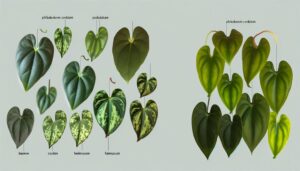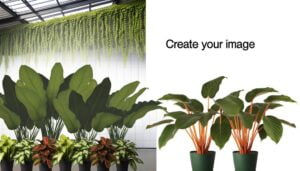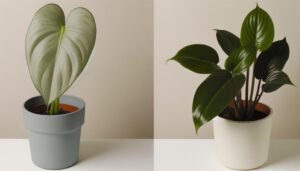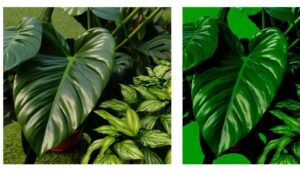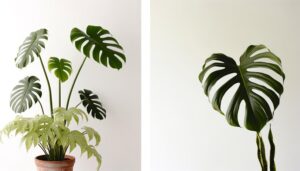Philodendron Jungle Boogie Vs Xanadu: Comparison Guide
Philodendron Jungle Boogie and Philodendron Xanadu, both from the Araceae family, display distinct variations. Jungle Boogie, hailing from South America, features deeply lobed, glossy, emerald green leaves with narrow, serrated edges, and thrives in low-light conditions.
In contrast, Xanadu, originating from Brazil and cultivated in Australia, is compact with broader, pinnate lobes, dark green, matte, velvety foliage, and requires moderate to bright, indirect light. Jungle Boogie grows upright, while Xanadu exhibits a dense, clumping habit.
Both species necessitate moist, well-drained soil, high humidity, and controlled fertilization. Explore to distinguish specific care and aesthetic nuances.

Key Takeaways
- Jungle Boogie has deeply lobed, elongated leaves, while Xanadu features broader, pinnate lobes with a more uniform, symmetrical pattern.
- Jungle Boogie’s glossy, emerald green leaves aid in water retention; Xanadu’s leaves are dark green with a matte, velvety texture.
- Jungle Boogie thrives in low-light environments, while Xanadu requires moderate to bright, filtered light to prevent leaf scorching.
- Jungle Boogie has an upright, compact growth habit; Xanadu presents a dense, clumping, sprawling form.
- Jungle Boogie needs watering every 5-7 days; Xanadu requires watering every 7-10 days, with both preferring consistently moist soil and high humidity.
Here’s a table chart for your title “Philodendron Jungle Boogie vs. Xanadu: Comparison Guide” along with an SEO-optimized title and meta description.
Philodendron Jungle Boogie vs. Xanadu – Key Differences
| Feature | Philodendron Jungle Boogie | Philodendron Xanadu | Similarities |
|---|---|---|---|
| Leaf Shape | Long, narrow, deeply serrated leaves with dramatic edges | Lobed, broader leaves with a more rounded shape | Both have unique, decorative foliage that adds a tropical touch to any space. |
| Growth Habit | Upright, compact, bushy growth with striking vertical appearance | Grows in a dense, compact mound with a spreading habit | Both grow well as indoor plants and maintain a bushy appearance without needing support structures. |
| Size | Can grow up to 3-4 feet indoors | Typically grows up to 2-3 feet indoors with a wider spread | Both are medium-sized, manageable houseplants, ideal for indoor environments. |
| Leaf Color | Dark to medium green leaves that stay consistently rich | Deep green leaves with a glossy sheen | Both varieties feature evergreen foliage that remains vibrant year-round. |
| Light Requirements | Prefers bright, indirect light but tolerates low light | Thrives in bright, indirect light but can handle lower light levels | Both can adapt to various lighting conditions, though they prefer bright, filtered light. |
| Watering Needs | Moderate watering, allowing soil to dry slightly between watering | Requires regular watering but prefers to dry out slightly between waterings | Both require well-draining soil and careful watering to prevent root rot. |
| Native Habitat | Native to tropical regions of South America | Native to Brazil and Paraguay | Both originate from tropical regions, making them well-suited for warm, humid environments. |
Origin and Background
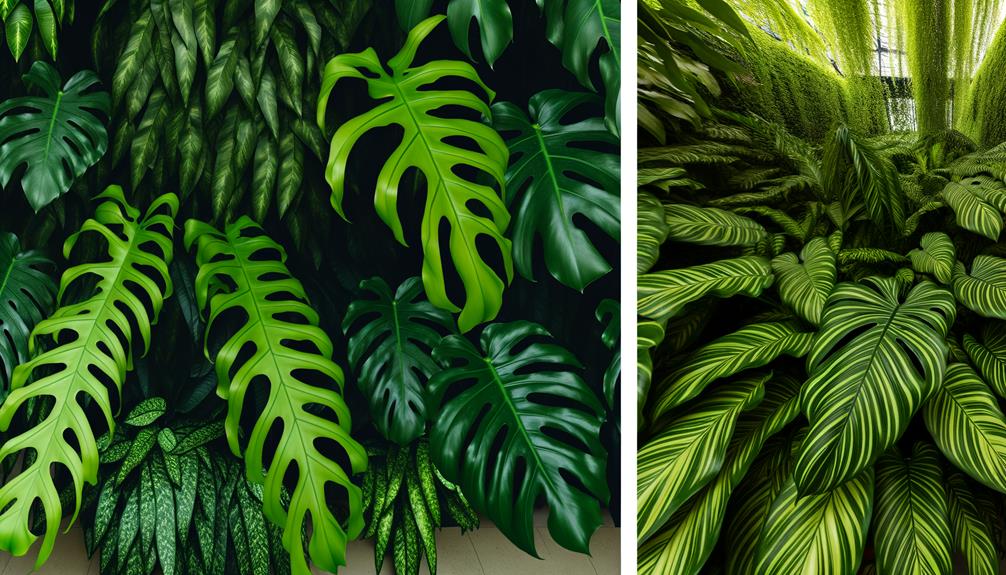
Philodendron ‘Jungle Boogie’ (Philodendron narrow) and Philodendron ‘Xanadu’ (Thaumatophyllum xanadu) are both members of the Araceae family, yet they originate from distinct geographical regions and possess unique evolutionary backgrounds.
Philodendron ‘Jungle Boogie’ hails from the tropical rainforests of South America, primarily in regions such as Colombia and Brazil. It thrives in humid, low-light environments, reflecting its adaptation to the understory of dense forests.
Conversely, Philodendron ‘Xanadu’ is native to Brazil but has been widely cultivated in Australia, where it was developed as a compact, ornamental hybrid. This species exhibits adaptations suitable for a range of light conditions, indicating its versatility and broader ecological amplitude.
These distinct origins underscore their divergent evolutionary paths and ecological niches.
Appearance and Foliage
The Philodendron Jungle Boogie and Philodendron Xanadu exhibit distinct morphological characteristics, particularly in their foliage. The leaf shape of Jungle Boogie is markedly elongated and serrated, whereas Xanadu’s leaves are more compact and lobed.
Additionally, color and texture variations, coupled with divergent growth habits, underscore significant botanical differences between these two philodendron species.
Leaf Shape Comparison
Examining the leaf morphology reveals significant differences, with Jungle Boogie exhibiting deeply lobed, elongated leaves while Xanadu features broader, more compact foliage with distinct, pinnate lobes.
The Jungle Boogie’s leaves are characterized by their narrow, serrated edges and pronounced sinus, contributing to a more dramatic, sculptural appearance. In contrast, Xanadu’s leaves are shorter and wider, with multiple smaller lobes that create a more bushy and dense visual effect.
The lobation pattern in Xanadu is more uniform and symmetrical, enhancing its ornamental value in landscaping applications. These morphological traits not only contribute to their aesthetic appeal but also reflect their adaptation to different light and moisture conditions, influencing their respective horticultural uses.
Color and Texture
Concerning chromatic and textural attributes, Jungle Boogie showcases a glossy, emerald green surface with a slightly leathery texture, while Xanadu features a more matte finish with a deeper, dark green hue and a softer, velvety feel.
The Philodendron ‘Jungle Boogie‘ (Philodendron narrow) has elongated leaves that exhibit a lustrous sheen, enhancing its vibrant green coloration. This glossy surface is indicative of its waxy cuticle layer, which aids in water retention.
Conversely, Philodendron ‘Xanadu’ (Philodendron bipinnatifidum) presents a subtler, matte leaf texture, attributed to its reduced cuticle thickness. Its darker green pigmentation is due to higher chlorophyll concentration, facilitating efficient photosynthesis in lower light conditions.
The velvety texture of Xanadu’s leaves provides a visually and tactilely softer experience.
Growth Habit Differences
In addition to their distinct chromatic and textural attributes, Jungle Boogie and Xanadu exhibit noticeable differences in their growth habits.
Jungle Boogie displays a more upright and compact stature, with elongated, serrated leaves that grow vertically, creating a dense, bushy appearance. Its compact nature makes it ideal for constrained spaces.
On the other hand, Xanadu demonstrates a wider, more sprawling form, characterized by broader, deeply lobed leaves that spread horizontally. This sprawling morphology allows Xanadu to cover more ground, making it suitable for larger areas.
These growth habit differences noticeably influence their respective spatial and aesthetic applications.
Growth Habits
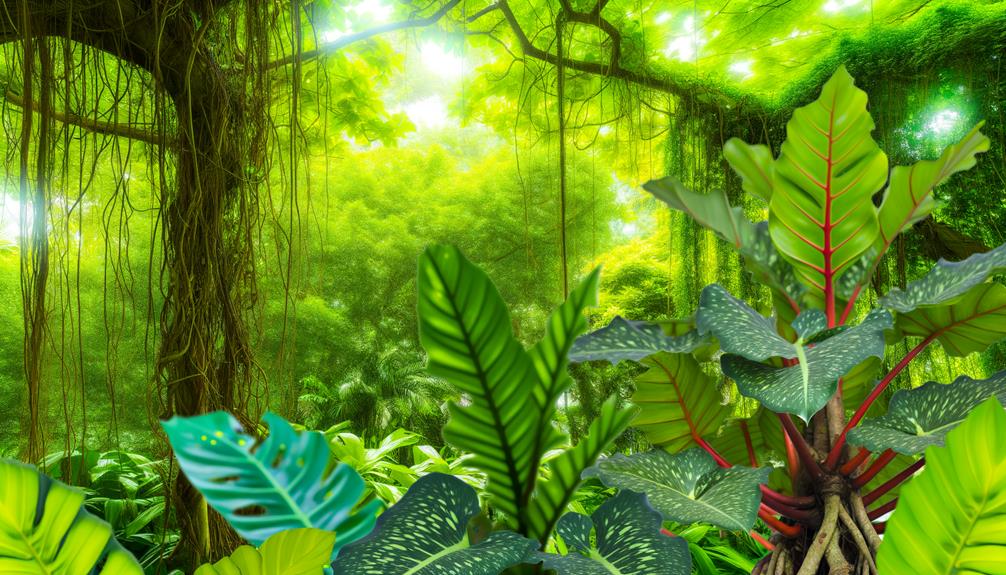
The growth habits of Philodendron Jungle Boogie and Philodendron Xanadu exhibit distinct morphological differences, with the former displaying a more upright and elongated leaf structure compared to the latter’s compact and bushy form.
Philodendron Jungle Boogie (Philodendron ‘Jungle Boogie’) features elongated, serrated leaves that grow in a more vertical orientation, contributing to its statuesque appearance.
In contrast, Philodendron Xanadu (Philodendron bipinnatifidum ‘Xanadu’) presents a dense, clumping habit with deeply lobed leaves, creating a more rounded and shrub-like profile.
The internode length in Jungle Boogie is more pronounced, facilitating a more spaced-out leaf arrangement, whereas Xanadu’s shorter internodes result in a tighter leaf cluster.
These growth habits notably influence their spatial requirements and visual impact in cultivated settings.
Light Requirements
The light requirements for Philodendron Jungle Boogie and Xanadu exhibit distinct preferences and tolerances, impacting their best growth.
Philodendron Jungle Boogie thrives in bright, indirect light, showcasing considerable adaptability to lower indoor light conditions, whereas Philodendron xanadu prefers moderate to bright indirect light for best photosynthetic activity.
Both species benefit from protection against direct sunlight exposure, which can lead to foliar damage and compromised physiological functions.
Preferred Light Conditions
Philodendron ‘Jungle Boogie’ thrives in bright, indirect light, whereas Philodendron ‘Xanadu’ exhibits ideal growth under moderate to bright, filtered light conditions.
Best light exposure for ‘Jungle Boogie’ involves ensuring it receives diffused sunlight, which aids in maintaining its vivid foliar pigmentation and elongated, serrated leaves.
Conversely, ‘Xanadu’ requires light that is not overly intense to prevent leaf scorching, yet sufficient to promote robust, compact growth and its characteristic lobed leaf morphology.
Both species belong to the Araceae family and demonstrate phototropic responses, adjusting their growth patterns based on light availability.
Ensuring appropriate light conditions is critical for photosynthetic efficiency, which directly influences their physiological processes such as chlorophyll production and overall plant vigor.
Indoor Light Tolerance
Indoor horticultural environments necessitate a nuanced understanding of light requirements to optimize the growth and health of Philodendron ‘Jungle Boogie’ and Philodendron ‘Xanadu’.
Both species belong to the Araceae family but exhibit divergent light tolerance. Philodendron ‘Jungle Boogie’ (Philodendron ‘Tiger Tooth’) displays robust adaptability to low light conditions, owing to its broader, elongated foliage which maximizes photosynthetic efficiency.
Conversely, Philodendron ‘Xanadu’ (Philodendron bipinnatifidum) requires moderate to bright indirect light to maintain its compact, finely lobed leaf structure. Insufficient light for ‘Xanadu’ results in etiolation, characterized by elongated stems and reduced leaf size.
Both species benefit from consistent light exposure, yet their distinct morphological attributes dictate their respective light tolerances within indoor settings.
Optimal Sun Exposure
Understanding the exact light requirements for best sun exposure is crucial for the thriving growth of Philodendron ‘Jungle Boogie’ and Philodendron ‘Xanadu’, given their respective morphological and physiological adaptations.
Philodendron ‘Jungle Boogie’ necessitates bright, indirect light to maintain its deeply lobed, elongated leaves, reflecting its adaptation to the understory of tropical rainforests. Excessive direct sunlight can cause photodamage, leading to chlorosis.
Conversely, Philodendron ‘Xanadu’ thrives in moderate to bright indirect light, mimicking its natural habitat’s dappled sunlight. Its compact, symmetrically lobed leaves can tolerate slightly lower light levels but may exhibit etiolation if deprived of adequate luminescence.
Therefore, understanding these nuanced photic requirements is pivotal for optimizing the photosynthetic efficiency and overall health of these philodendron species.
Watering Needs
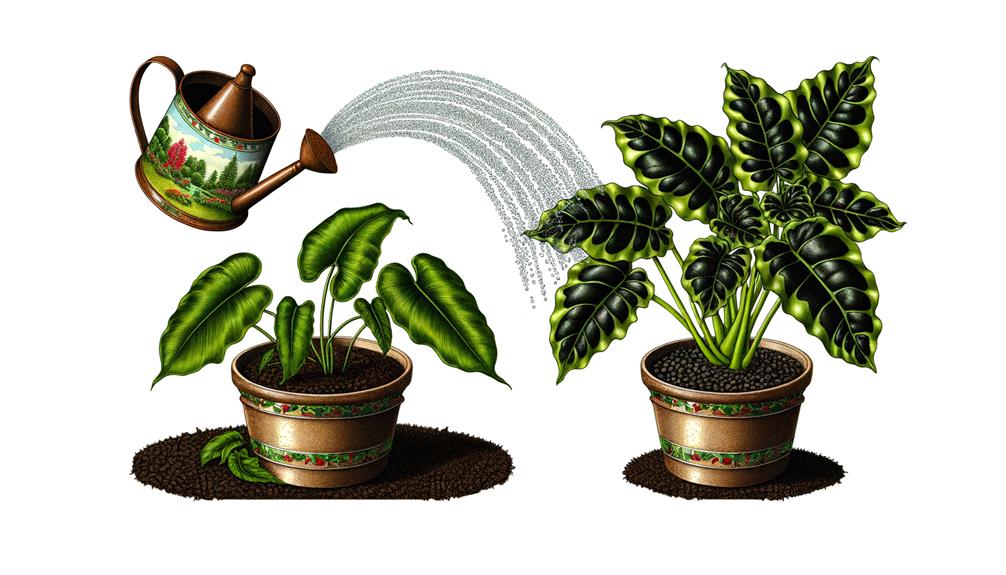
Adequate hydration is necessary for both Philodendron ‘Jungle Boogie’ and Philodendron ‘Xanadu’, yet their specific watering requirements diverge due to differences in their morphological and physiological adaptations.
Philodendron ‘Jungle Boogie’, with its elongated, deeply lobed leaves, exhibits higher transpiration rates, necessitating more frequent watering. Conversely, Philodendron ‘Xanadu’ has broader, more compact foliage, which reduces water loss and therefore requires less frequent hydration.
Key considerations include:
- Watering Frequency: ‘Jungle Boogie’ generally requires watering every 5-7 days, while ‘Xanadu’ can sustain longer intervals of 7-10 days.
- Soil Moisture Levels: Maintaining consistently moist, but not waterlogged soil is essential for both species.
- Humidity: Elevated ambient humidity benefits both, yet ‘Jungle Boogie’ exhibits higher sensitivity.
- Drainage: Ensuring adequate drainage prevents root rot and supports healthy root systems.
Soil Preferences
Both Philodendron ‘Jungle Boogie’ and Philodendron ‘Xanadu’ thrive in well-ventilated, organically rich potting mixes that promote excellent drainage while retaining enough moisture. Such soil mixtures typically consist of components like peat moss, perlite, and orchid bark, which collectively ensure an ideal balance of aeration and moisture retention. The substrate’s pH should ideally range between 5.5 and 7.0 to optimize nutrient uptake. Additionally, these philodendrons benefit from the inclusion of slow-release fertilizers to sustain growth over time. Proper soil composition mitigates the risk of root rot, a common issue in poorly-draining mediums.
| Soil Component | Function | Preferred Ratio |
|---|---|---|
| Peat Moss | Retains moisture | 40% |
| Perlite | Enhances drainage | 30% |
| Orchid Bark | Increases aeration | 20% |
| Compost | Enriches nutrients | 10% |
| 100% |
Temperature Tolerance
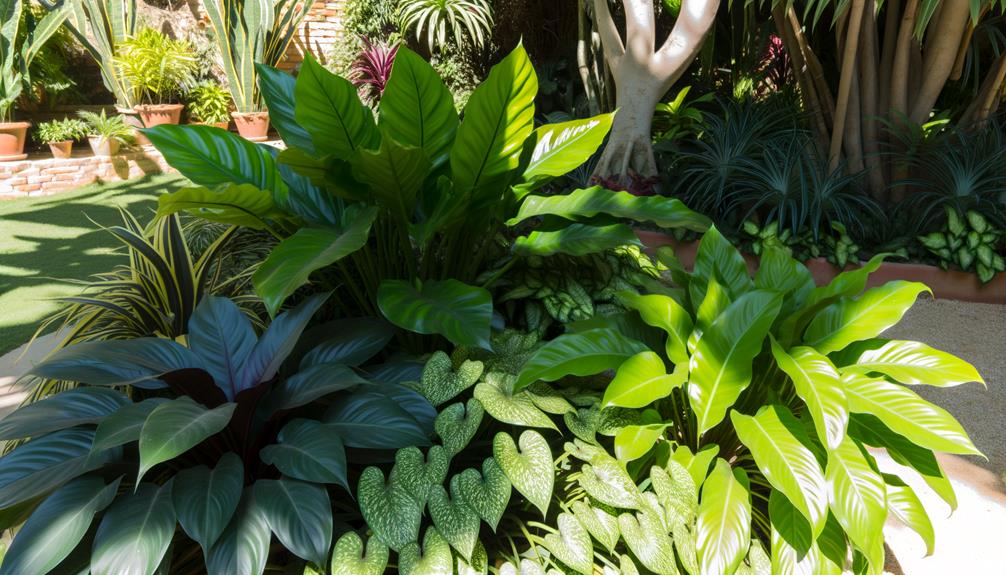
Temperature tolerance plays an essential role in the successful cultivation of Philodendron Jungle Boogie and Philodendron xanadu.
The ideal growth temperatures for both species generally fall within a range of 65°F to 85°F, but their cold resistance varies remarkably.
While Jungle Boogie exhibits moderate resilience to temperatures as low as 50°F, Xanadu demonstrates a more robust cold tolerance, enduring conditions down to 40°F without significant damage.
Ideal Growth Temperatures
Understanding the best growth temperatures for Philodendron ‘Jungle Boogie’ and Philodendron ‘Xanadu’ is crucial for optimizing their physiological development and promoting robust foliage. Both species thrive most effectively within specific temperature ranges that support their metabolic processes and overall health.
- Philodendron ‘Jungle Boogie’: Prefers temperatures between 65°F to 80°F (18°C to 27°C).
- Philodendron ‘Xanadu’: Flourishes in slightly warmer climates, with a favorable range of 70°F to 85°F (21°C to 29¼).
- Temperature Consistency: Both plants benefit from minimal fluctuations in temperature to prevent stress.
- Humidity Synergy: Increased humidity levels complement the preferred temperature ranges, encouraging vigorous growth and reducing leaf dehydration.
Following these guidelines guarantees that these philodendrons display their full aesthetic and biological potential.
Cold Resistance Comparison
How do the cold resistance capabilities of Philodendron ‘Jungle Boogie’ and Philodendron ‘Xanadu’ compare when exposed to suboptimal temperatures?
Philodendron ‘Jungle Boogie’ (Philodendron sp.) demonstrates moderate cold tolerance, enduring temperatures down to approximately 50°F (10°C).
Conversely, Philodendron ‘Xanadu’ (Philodendron bipinnatifidum) exhibits slightly superior cold resistance, withstanding temperatures as low as 45°F (7°C).
Both species, however, are inherently tropical and hence susceptible to chilling injury below these thresholds. Prolonged exposure to temperatures under 50°F (10°C) for ‘Jungle Boogie’ and under 45°F (7°C) for ‘Xanadu’ can result in foliar damage, chlorosis, and stunted growth.
Understanding these cold resistance parameters is essential for horticulturists aiming to optimize the cultivation and long-term health of these ornamental plants in non-tropical environments.
Humidity Levels
Both Philodendron Jungle Boogie and Xanadu thrive in environments with relative humidity levels between 60% and 80%, reflecting their native tropical habitats.
Proper humidity is essential to prevent xerophytic stress, which can lead to suboptimal growth and leaf desiccation.
To maintain ideal humidity levels, consider the following practices:
- Utilize a humidity tray to increase ambient moisture.
- Employ a humidifier to maintain consistent humidity, especially during dry seasons.
- Group plants together to create a microclimate with higher relative humidity.
- Regularly mist the foliage to replicate natural rainforest conditions.
Ensuring sufficient humidity not only promotes robust growth but also enhances the phenotypic expression of these species, contributing to their lush, verdant foliage characteristic of the Araceae family.
Fertilization Tips
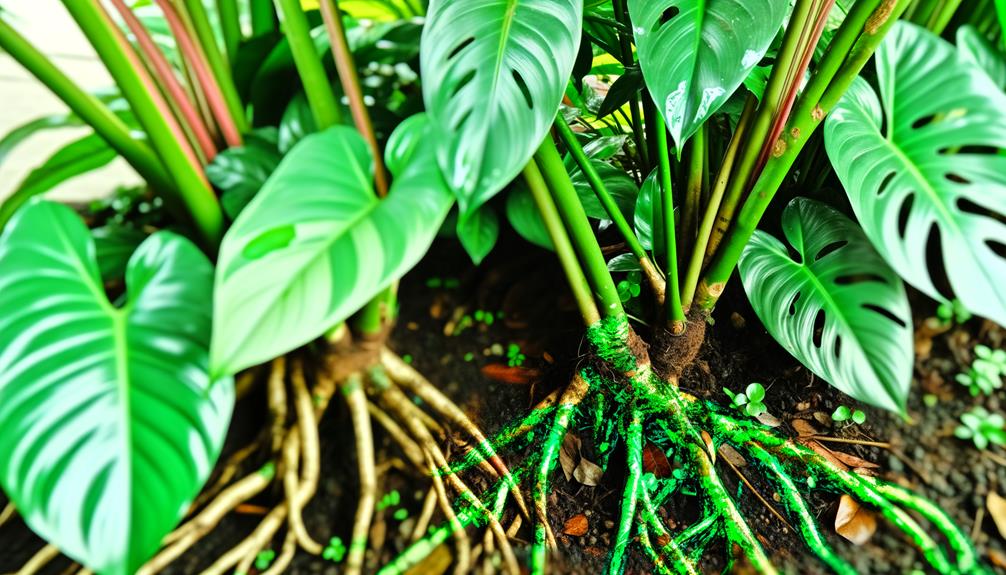
To optimize the growth and health of Philodendron Jungle Boogie and Xanadu, it is crucial to employ a balanced fertilization regimen tailored to their specific nutrient requirements. Both species, belonging to the Araceae family, benefit from a well-rounded, slow-release fertilizer rich in nitrogen, phosphorus, and potassium. Application should be performed bi-monthly during the active growing season, reducing to quarterly in dormant periods. Below is a comparative nutrient guideline:
| Nutrient | Jungle Boogie | Xanadu |
|---|---|---|
| Nitrogen (N) | Promotes lush foliage growth | Enhances leaf coloration |
| Phosphorus (P) | Supports root development | Boosts flowering potential |
| Potassium (K) | Improves overall plant vigor | Strengthens disease resistance |
Understanding these specific needs guarantees robust growth and vibrant health for both Philodendron varieties.
Pruning and Maintenance
Proper trimming and upkeep of Philodendron Jungle Boogie and Xanadu are vital for promoting healthy growth, preventing disease, and maintaining their aesthetically pleasing form. Regular trimming helps to manage the natural growth patterns of both Philodendron species, ensuring best light penetration and airflow. Employing sterile trimming tools is crucial to prevent pathogen transmission.
When trimming, focus on removing:
- Dead or yellowing leaves to prevent decay and disease.
- Leggy stems to encourage denser growth.
- Excess foliage to improve air circulation.
- Any damaged or infested parts to sustain plant health.
Philodendron Jungle Boogie, with its elongated, serrated leaves, and Philodendron Xanadu, characterized by its lobed leaves, both benefit significantly from these meticulous practices, thereby enhancing their overall strength and aesthetic appeal.
Common Pests
While careful pruning and maintenance strengthen plant health, Philodendron Jungle Boogie and Xanadu are still susceptible to common pests such as aphids, mealybugs, spider mites, and scale insects.
Aphids (Aphidoidea) often cluster on new growth, secreting honeydew that encourages sooty mold. Mealybugs (Pseudococcidae) appear as cotton-like masses, weakening plants by sucking sap. Spider mites (Tetranychidae) create fine webbing and cause stippling damage, leading to chlorosis. Scale insects (Coccoidea) attach firmly to stems and leaves, extracting essential fluids.
Regular inspection and early intervention using horticultural oils, insecticidal soaps, or biological controls such as predatory insects can mitigate infestations. Maintaining ideal humidity and avoiding over-fertilization also reduce plant vulnerability, ensuring robust Philodendron specimens.
Ideal Uses
Philodendron Jungle Boogie and Xanadu, both members of the Araceae family, excel in a variety of landscape and interior design applications due to their distinctive foliage and adaptability to diverse environmental conditions. These species are particularly prized for their aesthetic contributions and functional versatility.
- Landscape Design: Their robust, evergreen nature makes them ideal for creating lush, tropical-themed gardens.
- Indoor Decor: Both plants thrive as indoor specimens, enhancing air quality and adding visual interest with their intricate leaf patterns.
- Container Gardening: Philodendron Jungle Boogie and Xanadu can be effectively grown in containers, allowing for flexible placement.
- Erosion Control: Their extensive root systems help stabilize soil, making them suitable for erosion prevention on slopes.
Strategically incorporating these plants can notably enhance both indoor and outdoor environments.
Conclusion
The juxtaposition of Philodendron ‘Jungle Boogie’ and Philodendron ‘Xanadu’ reveals nuances in their morphology and cultivation needs. ‘Jungle Boogie’ thrives with distinctive narrow lobed leaves, while ‘Xanadu’ boasts broader, deeply lobed foliage.
Analogous to two dancers in a botanical ballet, each philodendron exhibits unique rhythms and movements, dictated by their environmental preferences. Understanding their specific light, water, and nutrient requirements is paramount for best growth, much like a conductor’s precision in orchestrating a harmonious symphony.

